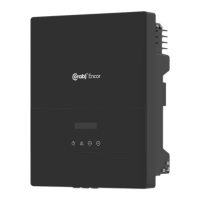
Do you have a question about the CORAB ENCOR and is the answer not in the manual?
| Dimensions | Not found |
|---|---|
| Weight | Not found |
| Power | Not found |
| Voltage at maximum power (Vmp) | Not found |
| Current at maximum power (Imp) | Not found |
| Open circuit voltage (Voc) | Not found |
| Short circuit current (Isc) | Not found |
| Module efficiency | Not found |
| Operating temperature | Not found |
| Maximum system voltage | Not found |
| Power Output | Not found |
| Efficiency | Not found |
| Cell Type | Not found |
| Warranty | Not found |
Details safety requirements for module installation and use, referencing standards.
Covers essential safety practices for installers, electrical shock risks, and environmental conditions.
Outlines safe procedures for handling, storing, and preventing damage during module use.
Emphasizes working in dry conditions and using insulated tools to prevent electrical hazards.
Provides guidelines for storing modules outdoors and avoiding damage during transport.
Warns against disconnecting under load, touching live parts, and the risk of burns/shocks.
Advises on avoiding rain, snow, wind, and protecting cables from sun and scratches.
Stresses keeping children away from the system during installation and transport.
Mandates using approved connectors and warns against removing them, which voids warranty.
Details requirements for roof coverage, ventilation, and fireproof materials for roof installations.
Warns that improper installation can create fire hazards for the building.
Recommends using appropriate fuses, circuit breakers, and grounding connectors.
Prohibits module use near flammable gases or in locations where they may accumulate.
Describes information found on the module's nameplate, including electrical ratings and dimensions.
Explains the serial number and barcode system for tracking module manufacturing and details.
Guides on selecting locations for maximum sunlight and proper orientation in hemispheres.
Advises against any shading of modules throughout the day for optimal performance.
Specifies recommended ambient and limit operating temperatures for module installation.
Details precautions for installations near the sea to prevent galvanic corrosion.
Lists areas and substances that modules must be protected from to ensure safety and performance.
Prohibits module placement in areas where flammable gases are generated or concentrated.
Specifies material requirements for mounting structures, emphasizing durability and UV resistance.
Stresses ensuring the installation method can withstand predetermined load conditions.
Advises on setting module height to avoid snow coverage and shading by plants/soil.
Recommends a minimum distance from the ground for ground-mounted systems.
Mandates providing adequate ventilation under the modules according to local regulations.
Details secure attachment methods and recommended clamp compression to avoid frame damage.
Explains clamp placement and quantity for module mounting, emphasizing frame protection.
Presents test and design loads for modules under normal and severe environmental conditions.
Details clamp positions and load specifications for mounting modules on short sides.
Details clamp positions and load specifications for mounting modules on long sides.
Details screw mounting methods, dimensions, and load specifications for module installation.
Details terminal clamp positions on short sides and load specifications for module installation.
Details terminal clamp positions on long sides and load specifications for module installation.
Details screw mounting on long sides, dimensions, and load specifications for module installation.
Emphasizes using compatible components to prevent galvanic corrosion and warranty issues.
Advises against mixing modules with different configurations in the same system.
Guides on organizing cables, protecting them from elements, and avoiding damage.
Explains connecting modules in series for voltage and parallel for current in system design.
States maximum system voltage ratings based on product family and standards.
Recommends using appropriate string fuses for circuit protection based on module and local codes.
Advises selecting cable cross-section and connector capacity for maximum short circuit current.
Warns against overtightening cables, as damage is not covered by warranty.
Stresses observing the cable manufacturer's specified bending radius for cables and connectors.
Highlights the decrease in isolation resistance with more modules, potentially causing inverter faults.
Recommends using original connectors, warns against alternatives invalidating warranty.
Advises mating connectors until a click is heard for reliable connection and moisture prevention.
Warns of poor connectivity and leakage from long-term wet exposure, recommending inspections.
Advises consulting designers and local utilities for grid connection policies and permits.
Recommends installing lightning protection for larger installations per local regulations.
Refers to regional/national standards for grounding and connector type requirements.
Explains connecting the anodized aluminum frame to the system ground wire for safety.
Specifies using pre-drilled holes marked with a grounding sign for grounding purposes.
Recommends performing regular inspections and maintenance during the warranty period.
Details key visual checks including cell color, glass integrity, sharp objects, shading, corrosion, and burns.
Provides guidelines for cleaning modules using distilled water, soft cloths, and mild agents.
Recommends checking connectors and wiring for damage, corrosion, and current leakage semi-annually.
States the manufacturer's disclaimer for losses arising from installation, operation, or maintenance.
Notes that information is based on knowledge but does not constitute a warranty.